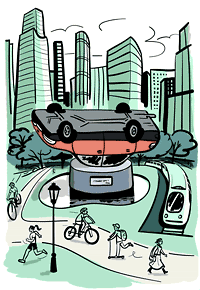Last days of the ICE Age

How does a society enter the future?
With bright red flags flying, smiling faces upturned, a rose-fingered dawn breaking on the horizon, an overture swelling in the background?
Contrary to socialist propaganda and Hollywood myth, most communities blunder into the future, often stumbling backward, groping for a curb or handhold like a blind man suddenly thrust into a busy street in a strange city.
Metropolitan Puget Sound is currently in the midst of entering its own future, along with the rest of Western industrial society. It is crossing from one social and economic epoch into another.
The past may be called the ICE Age, the "ICE" here being not continent-sized glaciers but the Internal Combustion Engine. This modern ICE Age is barely a century old, but it completely transformed the contours of our physical and cultural landscape.
The effects of its end will be no less dramatic. What will follow it doesn't have a name yet, but it looks strangely familiar.
The border between the ICE Age and post-ICE Age is hazy and indistinct to those feeling their way on the ground, but it is appears as a bright, swift river to those watching from a little altitude. Voters have been inching along the banks of this regional Rubicon for over a decade by approving Sound Transit in 1996, by gambling on an expanded monorail in 1997 (and ultimately folding a losing hand), by upholding higher state transportation taxes in 2005, and by sending Alaskan Way Viaduct planners back to the drawing board in 2006.
With each election, the public has backed a little further away from the automobile-driven imperatives that have shaped our transportation system and patterns of regional and urban development since the First World War. The final fording looms just ahead: the Nov. 6 election on the Regional Transportation Investment District (RTID) plan for $18-billion-plus worth of transit and highway improvements over the next decade or more.
The RTID package does not satisfy the true believers on either side of the great lanes-versus-trains debate that has divided the region since the 1960s, but its approval would irrevocably tip the balance in favor of transit and other non-ICE Age modes of transportation, such as bicycles, ferries and electric vehicles. Personal transport per se will not cease to exist — it is too ingrained in our culture and economy — but petroleum-powered cars and their insatiable appetite for oil, concrete and real estate will no longer set the pace for future mobility and development.
The impact that the automobile has had on us as a region, nation and civilization is impossible to overstate, and it is all the more dramatic for the relative brevity of its reign. Washington's first automobile (which was electric, by the way) arrived in Seattle in the summer of 1900. It was little more than a rich man's toy in a city with few paved roads. In town, most folks walked or rode streetcars on the city's rapidly expanding network of privately financed and managed street railways. The upper classes had horses and carriages, the poor had shank's mare.
Longer-distance travel within and beyond the region was powered by steam in the form of railroads and "mosquito fleet" ships. Paved roads between cities were virtually unheard of.
Enter the Model T in 1908. Henry Ford did not invent the gas-powered automobile but he made it practical and affordable for the masses. To advertise his product, Ford underwrote a transcontinental car race in 1909 from New York City to Seattle's Alaska-Yukon-Pacific Exposition on the University of Washington campus. A Model T crossed the finish line first after 23 days hard driving, but was later disqualified for some illegal repairs mid-trek.
Just four years later, local demand for Ford's Tin Lizzies was great enough to justify construction of an assembly plant on the south shore of Lake Union (now occupied by the Shurgard headquarters). By World War I, autos had all but replaced horses as a mode of personal mobility and their swelling numbers pushed Seattle's private streetcar monopoly to unload its system on a gullible city government.
Interurban railways were simultaneously challenged and displaced by county and state highways whose expansion accelerated after the federal government began funding road construction in 1916. The death knell for rail was sounded in 1933 when the new Pacific Highway and Aurora Bridge opened without any tracks for local or interurban transit, although Seattle voters and commuters stood by their streetcars until the eve of World War II, despite the best efforts of car, oil and tire companies to bankrupt and derail street railways here and across the nation.
And so one transportation epoch passed and another began, not with a single heroic flourish, but incrementally through thousands of tiny gestures by individuals, corporations and governments. If one event signaled the official dawn of the ICE Age in our region, it was the opening of the first Lake Washington floating bridge on June 3, 1940 — a gleaming conduit of concrete that opened the Eastside to a future accessible only by automobile.
Following World War II, a shiny new car and an open road became synonyms for success and freedom, and clover leafs of cement brought more than good luck to suburban developers. The National Highway Act of 1956 supercharged road construction with federal and state subsidies that dwarfed public sums previously spent on railroads or any other form of transportation.
As the ICE Age shifted into overdrive, obstacles loomed ahead. The death toll from accidents climbed, pollution from auto exhaust poisoned the air and water, highways bisected neighborhoods and paved over farms and forests, and the nation's addiction to oil exposed it to ancient Middle Eastern passions and despoiled its own waters and wilderness.
Then came global warming: a grim prognosis of planetary meltdown fueled in large part by the internal combustion engine's thirst for petroleum and its deadly flatulence of greenhouse gases. The ICE Age was melting in its own body heat.
Future historians will likely record that the gas-powered automobile was doomed by its own popularity. Urban streets laid out for streetcars before World War I could absorb only so many vehicles, and suburban sprawl hit and rebounded against natural and political growth limits, turning once leafy bedroom communities into high-rise edge cities.
The inevitable result of too many vehicles competing for too few lanes is near-perpetual traffic congestion. As the daily tides of commuters wash back and forth across the Puget Sound region, former "peak hours" have lengthened into dawn-to-dusk gridlock on major highways. New lanes only invite more vehicles, and highway capacity (and attendant local streets and parking lots) can never catch up with demand without turning the region into an asphalt desert.
And so we stand in the last days of the ICE Age. The future is visible in the distance — and in the not-too-distant past. Urban and regional planners have already drawn up the blueprints for denser downtowns, urban villages, close-in work places, streetcars, interurban trains, "mosquito fleet" ferries, smaller electric vehicles, bicycles and even people walking — not to attain their personal fitness goals, but just to get from point A to point B. Could horses and buggies be far behind? Don't laugh.
Passage of the roads-and-transit plan will not instantly unclog highways nor usher in some modern version of a 19th-century City Beautiful utopia overnight. It will, however, mark a tipping point not unlike the predicted thawing of the polar ice caps, a one-way threshold of no return. We will always need roads and highways, but once the momentum of transportation investment steers away from the gas-powered automobile in favor of transit and other alternatives, there will be no going back.
Once the ICE Age begins to recede, it cannot be reversed, and we will find ourselves delivered into the future.
Walt Crowley wrote the official history of Metro Transit's first 20 years and co-authored the centennial history of the Washington State Department of Transportation. He was co-founder and director of HistoryLink.org, the online encyclopedia of Washington state history.